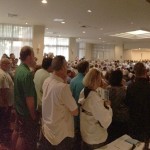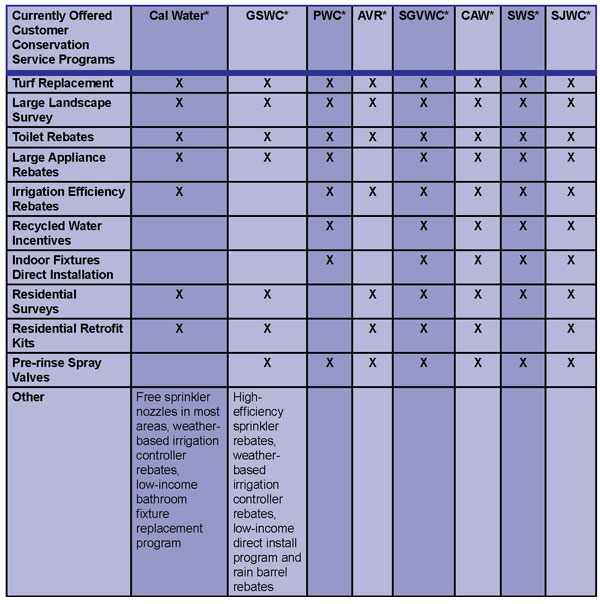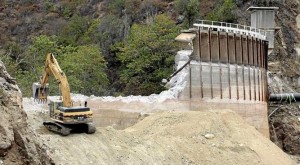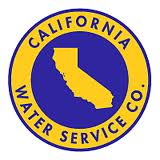In response to a California Public Utilities Commission (Commission) resolution ordering its jurisdictional water companies to comply with Governor Jerry Brown’s executive order requiring mandatory water-use cutbacks and the State Water Resources Control Board’s (State Water Board) requirement to reduce urban water use by an average of 25 percent statewide from 2013 consumption rates, investor-owned water utilities (IOUs) held 95 customer meetings throughout California between May 15 and June 30. The meetings were attended by more than 16,000 customers and provided them an opportunity to understand and respond to the state’s water-use reduction policies and the IOUs’ approaches to complying with those mandatory reductions.
The IOUs are in different stages of their Schedule 14.1 mandated water reduction plans. IOUs were directed to file and activate their Schedule 14.1 Water Shortage Contingency Plans with the Commission by mid-June, with compliance timeframes to begin as soon as possible thereafter. The plans detail the companies’ approaches and the increasingly strict water-use stages necessary to achieve the mandated water-use reductions.

Because water usage levels and conservation programs differ throughout the state, the State Water Board’s mandate of a 25 percent average statewide reduction provides for individual water provider reduction targets ranging from four to 36 percent for the 411 water utilities and agencies reporting to the State Water Board on a monthly basis. Like their public agency counterparts, the water IOUs are initiating stages of their water shortage plans at different times and to varying degrees. However, the water IOUs generally have moved forward with their plans aggressively, largely due to the Commission’s directives.
Additionally, as directed by the Commission, the water IOUs are keeping track of any surcharges collected separately from regular revenues and allocating money to the previously approved accounts known as “lost revenues,” “conservation” or “revenue adjustment mechanism.” Utilities typically file an advice letter request seeking Commission approval for recovery, a process that undergoes full review before any decisions are made.

The state’s largest water IOU, California Water Service (Cal Water), which serves nearly 2 million Californians, activated Stage 2 of its Water Shortage Contingency Plan. This includes assigning customers in Cal Water’s districts individualized, mandatory water budgets that correlate with the districts’ reduction requirements, implementing outdoor irrigation schedules, assessing penalties for violating prohibited water uses and adding surcharges to bills for excessive water use above those budgets. Cal Water completed its customer meetings in May and implemented its plan on June 1, 2015.
Los Angeles County-based Park Water Company (PWC) is in Stage 1 of its plan, which covers multiple prohibited uses (mainly outdoor usage restrictions) and the installation of flow restrictors and real-time measurement devices. Because it has a much higher conservation mandate, Apple Valley Ranchos Water Company (AVR) in San Bernardino County already is in Stage 2. This encompasses all the prohibitions of Stage 1 plus limitations on outdoor watering to only two days a week for non-residential customers and requirements for customers to fix leaks within three days of being notified by AVR. With respect to residential customers’ usage in excess of their allocation (in AVR’s case, 2013 consumption levels minus 28 percent, which translates to between 7,362 and 11,968 gallons per month depending on the time of the year), the regular rate is charged plus a drought emergency surcharge equal to the utility’s tier 1 rate. Non-residential customers are charged at the regular rate plus 15 percent.
Because mandated water usage reduction targets vary by company, the decision to activate a particular stage of a reduction plan also varies by company. Likewise, the strategies to achieve mandated reduction targets vary. Some utilities apply system-wide average reduction targets by customer, while others apply individual targets based on individual customer usage. For example, Golden State Water Company (GSWC), which serves more than a million people throughout the state, applies its reduction targets based on individual customer usage, while California American Water’s (CAW) individual customer water reduction targets are calculated using each of its district’s system-wide averages throughout the state.

Due to constraints imposed by its local wholesale district, San Jose Water Company (SJWC) has implemented Stage 3 of its Water Shortage Contingency Plan. This stage includes mandatory outdoor water-use restrictions with a limit on irrigation to two days per week. Customers are required to fix leaks, broken irrigation systems and broken plumbing fixtures within 72 hours if notified to do so by SJWC. The residential allocation program is based on a 30 percent reduction from 2013 average residential customer usage on a monthly basis. SJWC’s drought surcharges are activated for usage above the monthly allocation, beginning with an amount equivalent to SJWC’s highest tiered rate.
To get the word out and encourage customers to attend informational meetings, the IOUs employed numerous communication channels. For example, GSWC sent direct mail pieces to customers and posted notices on the company’s website, along with a complete schedule of meetings. In addition to direct communications to their customers in Los Angeles County, Suburban Water Systems (Suburban) participated in several town hall meetings to speak with local city officials and answer questions. The company also has been holding a series of meetings with city and school officials in its service areas that will continue into August.

Cal Water also employed direct mail and its website to promote the customer meetings as well as engaged heavily in social media and placed advertisements. San Gabriel Valley Water Company (SGVWC) used newspaper advertisements, website postings, direct mail and customer service representatives to get the word out. All of the IOUs worked with local media to inform customers of the meetings.
The meetings, ranging in attendance from less than 100 up to about 800, focused primarily on reviewing the new rules for customers’ water usage, as well as discussing the multiple conservation and incentive programs available to customers by the IOUs. GSWC held 35 public meetings to cover its customer service areas throughout the state, with more than 400 customers in a single meeting. SGVWC held two meetings for its two divisions in Los Angeles and San Bernardino counties, including its Fontana Water Company meeting in the latter county, which had more than 300 participants. Likewise, Suburban held two public meetings – one in La Mirada that drew about 200 attendees and one in West Covina with 230 customers. Cal Water conducted 25 customer meetings with as many as 800 attendees in a single meeting. PWC and AVR held a combined total of three meetings with approximately 500 attendees at the AVR meeting. CAW held seven customer group meetings ranging from 40 to approximately 200 participants.
A majority of the time at the meetings was devoted to answering customers’ questions and addressing their concerns. Common questions and concerns varied among customers, but the majority centered on water waste, usage restrictions and enforcement mechanisms as well as the IOUs’ specific requirements and surcharges and details of their rebate/conservation programs. Others focused on how to monitor real-time water usage and appeals of individual allocations. Many questions arose regarding future supplies and the availability of utility conservation and rebate programs. Responses to the questions were tailored to the IOUs’ specific districts, service areas and customer needs.
Through the public meetings, customers learn firsthand that when it comes to conservation, all of the IOUs currently offer an extensive selection of programs (see chart); however, in light of the drought, the IOUs are now offering new programs. For instance, GSWC has implemented a turf-removal program as well as Ultra-High-Efficiency Toilet, High-Efficiency Clothes Washer and Rain Barrel Rebate programs in service areas where not previously offered. In recognition of Smart Irrigation Month, GSWC has asked customers who have converted lawns to drought-tolerant landscapes to share their photos for a chance to win a $100 credit toward their water bill. The company is highlighting photos on Twitter throughout July, and winning landscapes will be featured in the August/September edition of its Waterways e-Newsletter (see www.gswater.com/contest).
Suburban has added landscape workshops for customers, purchased additional conservation kits and increased the number of requests for the free toilet-replacement program. In light of a number of customer inquiries, Cal Water is now offering a turf-replacement rebate program and seeing unprecedented utilization of its water-use efficiency evaluation program, while SGVWC is offering commercial, industrial and institutional (CII) water-use audits. CAW expanded its turf-replacement program both in total dollars for the entire program and allowances to individual customers. For residences, CAW now offers a $2.00 per-square-foot allowance, up to a maximum of 3,000 square feet, which represents a doubling of the per-square-foot allowance and an increase in the maximum square feet of 150 percent. CAW also expanded rebates to include artificial turf as well as pool covers and rain barrels.

To boost conservation efforts, CAW hosted a door-to-door walk and talk customer campaign in April and July aimed at promoting water savings and educating customers on ways to conserve water during the drought. Along with the customer campaign, CAW extended its drought communications to include email blasts to customers regarding rebates on pool covers and turf replacement as well as tips on how to save water. CAW also ran advertisements on national and local news websites, such as the New York Times and weather.com, and on social media. On July 20, National Public Radio began running a CAW sponsorship ad that will air until late November.
PWC will be offering a new conservation/communication mobile app pilot program with the technology firm, Dropcountr, by the end of July. The program will allow customers to track their water-use history and notify them if they are meeting their goal. PWC will use the app to communicate with customers on conservation programs and rebates as well as provide updates on mandatory restriction notifications, events, etc.
* All of these programs are directly supplied by the IOU or sponsored by the IOU and referred to a third-party provider.
Note: Cal Water offers additional programs, including conservation kits, high-efficiency toilet, clothes washer and toilet rebates and other outdoor rebates.
Note: CAW offers education only – no financial assistance for recycled water incentives.
Note: GSWC offers additional programs, including a CII Survey Program, CII Direct Install Program, free outdoor conservation kits, free indoor conservation devices, free spray hose nozzles, free moisture meters and CII rebates. Not all programs are available in all service areas. GSWC currently is reviewing a pilot social media program (Dropcountr, AquaHawk, etc.).
Finally, each IOU recognizes the importance of keeping their employees informed about what the companies are doing relative to the drought. GSWC has developed talking points to equip staff with answers to questions or concerns customers may have about the drought. Additionally, staff receives regular updates on developments and drought news. Similarly, Cal Water has provided their staff with talking points and resource guides, while keeping up-to-date information on the website and intranet. SGVWC has ongoing internal conservation meetings and has provided employees with a list of frequently asked questions. Suburban holds informational meetings with employees and sends regular updates to them with current program information via email and the company’s monthly newsletter.
SJWC’s managers meet with the meter readers, field service inspectors and conservation staff weekly to provide updates regarding the drought, customer concerns and Schedule 14.1 and its implementation. There also is a monthly meeting with staff of the Distribution Systems Department. CAW has conducted employee meetings and workshops with handouts for employees to give customers. PWC and AVR will be providing employees with a fact sheet detailing the state mandates and the company’s Water Shortage Contingency Plan, including information about PWC’s and AVR’s conservation rebates and programs. Additional training will be provided to customer service employees and, as needed, to other front-line employees.






